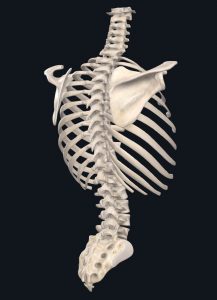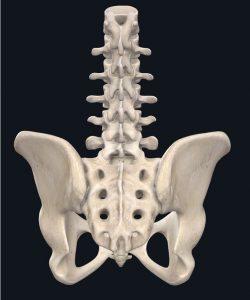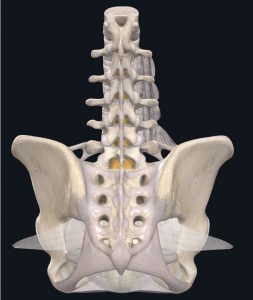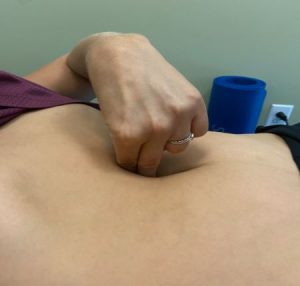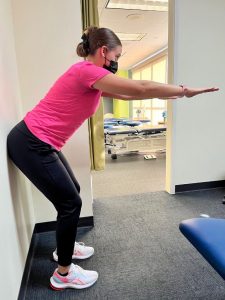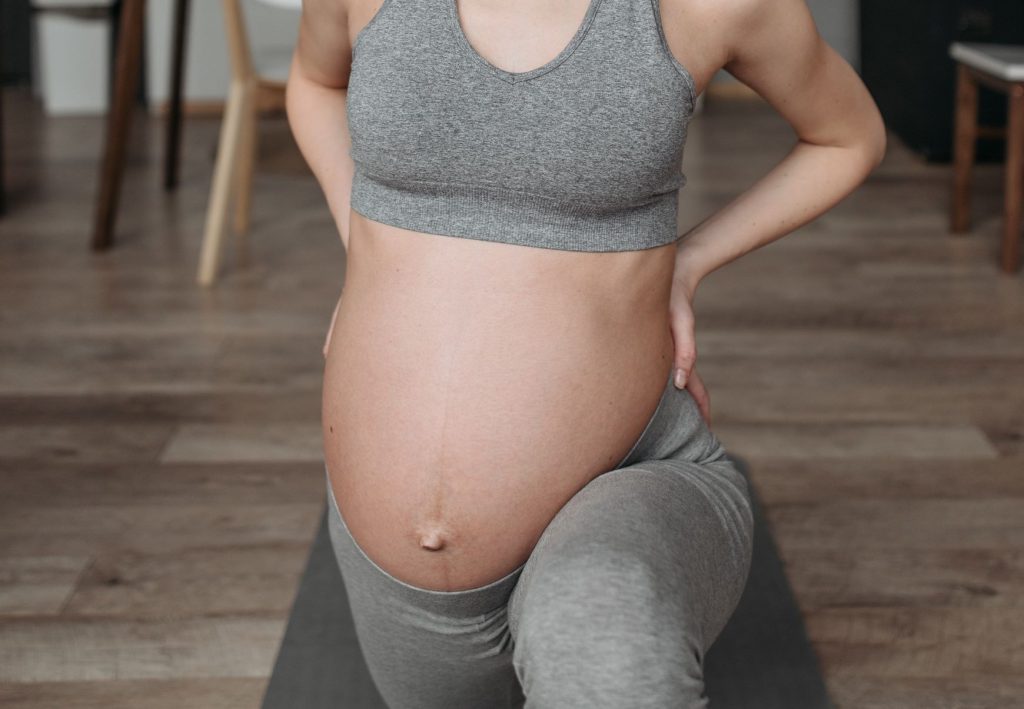
Congratulations are in order!
Either you have recently discovered that you are pregnant and expecting, or you have already welcomed your new bundle of joy into the world!
But wait… what’s this new back pain that keeps disrupting daily activities?
You may be experiencing pregnancy-related back pain, which is very common in women during or after pregnancy.
In fact, The American Pregnancy Association says that 50-70% of women may experience an episode of back pain throughout their pregnancy.
Back pain can occur at any time both during and after pregnancy. Most studies show the most frequent onset of back pain occurring during the 5th and 7th month; however, back pain can occur as early as 8-12 weeks and last up to 4th months postpartum.
There are a multitude of reasons why you could be experiencing back pain, so let’s take a closer look at how the body’s anatomy can change during and after pregnancy. Understanding the body during this exciting time can clarify why a new parent may experience back pain.
Looking for some help? JACO Rehab schedules 1-on-1 physical therapy sessions for over 50 minutes. We’ve got your back. Contact us to schedule an appointment.
Spine and Pelvic Anatomy
To better understand how changes in hormones and posture during pregnancy can result in back pain, you need to understand a little bit about the anatomy of the spine and pelvis.
If you are interested in reading more about general changes during pregnancy, you can deep dive into this article on Physiopedia.
The spine is made up of the cervical spine (neck), thoracic spine (mid back), and lumbar spine (low back), and encompasses a total of 24 vertebral segments (7 in the neck, 12 in the mid back, and 5 in the lumbar spine).
- The Spine: Cervical to Sacrum | Image courtesy of Complete Anatomy
- The Spine: Lumbar, Sacrum, and Pelvis | Image courtesy of Complete Anatomy
Each segment of the spine has a natural curvature either slightly lordotic (concave) or kyphotic (convex).
Any change in the natural curvature of the spine can cause either lengthening or shortening of the muscles and ligaments around it, affecting their function. Changes can also add extra compression to specific spinal segments causing limited mobility.
The sacrum, which is located directly below the lumbar spine, attaches to the hips via the sacroiliac joints on either side, forms the posterior wall of the pelvis, and strengthens/stabilizes the pelvic contents (think of the uterus and pelvic floor muscles).
The sacroiliac joints (think of the area around your low back dimples) rely heavily on a large complex of ligaments (these tissues connect bones to one another) to provide stability.
Let’s go into more detail about hormonal and postural changes during pregnancy and how they can contribute to back pain.
2 Hormones that Change the Body During and After Pregnancy
Relaxin
Relaxin, which increases towards the end of pregnancy, helps to prepare the body for delivery by causing loosening of the ligaments that surround the pelvic area.
- Back View: Ligaments Surrounding Sacrum and Pelvis | Image courtesy of Complete Anatomy
As a result, the body needs more muscular stability surrounding the pelvic girdle including the core, low back, and hips to account for the lack of ligament support. A stable pelvic girdle will decrease stress on your low back and sacroiliac joints.
Relaxin is most active around the 10th week of pregnancy, and is the greatest during the second trimester. Its effects last through the third trimester and up to 12 weeks postpartum.
Progesterone
Early in pregnancy, progesterone levels increase which can contribute to back pain.
Progesterone works to reduce the tone of smooth muscle in order to reduce premature contractions and maintain the viability of the pregnancy, but as a result, can cause constipation and general feelings of tightness/stiffness.
With increased episodes of constipation, straining during bowel movements can further contribute to episodes of back or sacroiliac pain and pelvic floor issues.
Postural Changes During and After Pregnancy
Your body changes in multiple drastic ways during pregnancy. It’s no wonder the body feels off! Consider:
- The added weight of a growing fetus
- Increased fat storage
- More breast tissue
How do these factors cause pain?
A growing belly will shift your center of gravity. As a result, you’ll find yourself leaning backwards to feel steady while walking or standing.
Larger breasts can also influence center of gravity, causing increased lordosis of the neck and low back as your body tries to adapt over your pregnancy term.
Resulting postural adaptations typically cause muscle imbalances including tightness and/or weakness of the glutes, iliopsoas (hip flexor), core, and pelvic floor musculature. These imbalances have the potential to cause pain.
These changes can last as long as up to 8 weeks postpartum. Sometimes, these postures can last longer due to the similar demands of carrying a newborn.
Diastasis Recti and Its Influence on Back Pain
Diastasis Recti is a common term doctors use to describe the separation of the abdominals, which frequently occurs during the 2nd trimester, and according to the Cleveland Clinic occurs with ~ 60% of pregnancies.
This typically weakens the abdominals muscles, specifically the rectus abdominis, which help to stabilize the pelvis and low back when bending and lifting.
- Diastasis Recti – Separation of “6-Pack” Abs
Remember that poor coordination of pelvic girdle musculature, including your core, has the potential to cause pain during activity.
Diastasis recti can resolve on its own. If you suspect that your diastasis recti is influencing functional issues, like…
- Weakness when getting out of bed in the morning
- Difficulty bending and lifting without pain
- Pain with return to exercise
… then conservative care with physical therapy may be a great option.
Only severe cases may require surgical intervention.
Is Exercise Safe During and After Pregnancy?
The answer is a BIG yes!
There is currently no scientific evidence that exercise is harmful during or after pregnancy. In fact, exercise can help decrease the risk of preeclampsia (pregnancy related high blood pressure), gestational diabetes, excessive weight gain, and even postpartum depression.
If you were previously active prior to pregnancy, there is no need to stop exercising unless otherwise instructed by your doctor.
However, if you notice any of these symptoms as a result of any activity (whether it’s exercise or not):
- Abdominal pain
- Belly heaviness
- Leakage
Make sure to follow up with your doctor.
Physical Therapy for Pregnancy-Related Low Back Pain
Physical therapists play a crucial role in prescribing safe and appropriate exercises to strengthen the abdominals to both prevent pregnancy-related back pain and facilitate recovery.
At JACO Rehab, we know all about the changes that occur to the body during pregnancy and how to safely modify exercise as applicable to you. We want you to keep doing the things you love, whether it’s running, swimming, or even participating in crossfit.
An Exercise to Combat Low Back Pain After Pregnancy
If you have already welcomed your beautiful baby into the world, then you know the hard work is just beginning!
Caring for a newborn includes a lot of bending, lifting, carrying, and pushing.
Ensuring correct body mechanics when picking up your carrier, bending over your baby’s crib, and carrying your baby can help to mitigate the risk of developing back pain postpartum.
Here is an example of a movement that targets proper bending form/mechanics when caring for your baby.
Practice Hip Hinging to Bend Forward
1. A good place to work on learning to hip hinge is with your butt against the wall, your feet slightly out in front of you, and arms outstretched while maintaining a soft bend in your knees.
2. Think about bracing your abdominals, keeping your core tight while maintaining a steady breath. Do not hold your breath.
3. Think about squeezing your butt cheeks together like you are trying to pinch a dollar bill and hold onto it tight.
4. Once you can feel your lower abdominals and butt tight, think about sliding your butt up along the wall while leaning forward and maintaining a steady trunk position.
- It should feel like you are folding over at the hips, not at your back.
- You should also feel a slight pull in the back of your thighs, which is just your hamstrings stretching.
Once you have mastered this exercise, you can progress by stepping away from the wall and adding resistance like bands or dumbbells. At that point, you’re essentially deadlifting!
If you are having trouble learning this exercise or need more tips on how to bend, lift, and carry to prevent or decrease back pain, see a physical therapist.
When in Doubt, See Physical Therapy!
If you or someone you know has low back pain during or after pregnancy, we would be happy to help!
Please call JACO Rehab at (808) 381 – 8947 to schedule an appointment with us. Mahalo!
Written by Jenn Lewis, DPT
